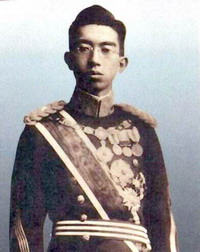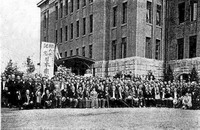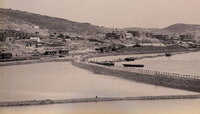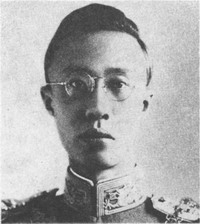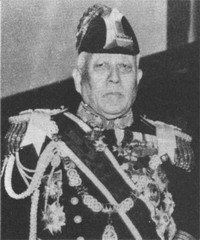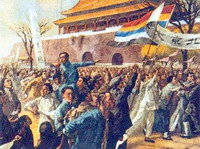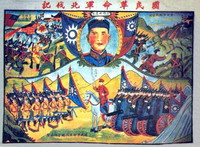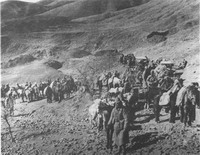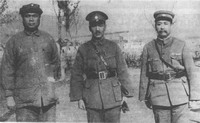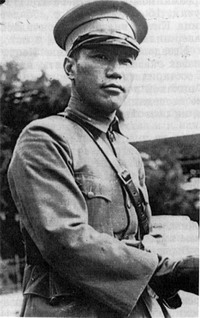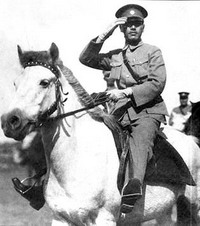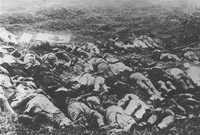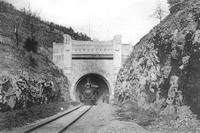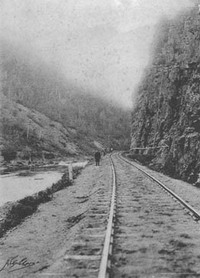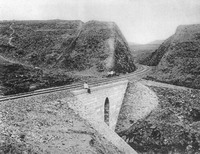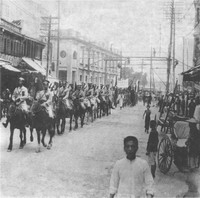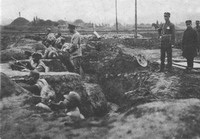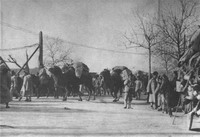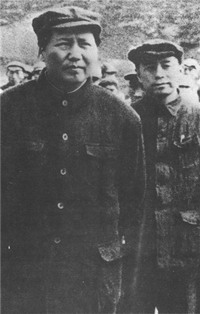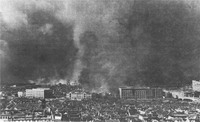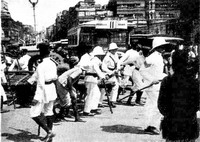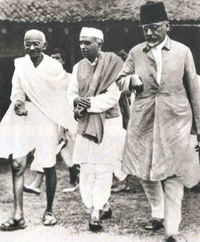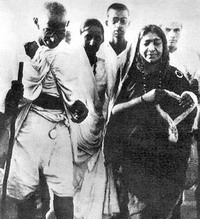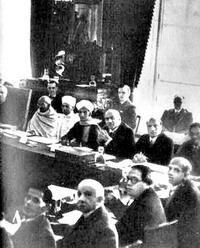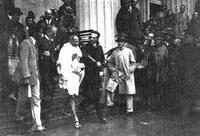Japan
during World War II Japan, speaking on the side of the Entente, occupied the German colony in the Far East and Pacific Basin. Japan maximally exploited the situation to increase their military capabilities, and above all the fleet. The flip side militarization country was poverty. In August and September 1918 the country a wave of "rice riots" - spontaneous demonstrations against rising prices for basic foods. Hardly had the government to suppress these statements, as in 1919 the country embraced the strike movement of workers, and in the main colony of Japan - Korea antyyaponske uprising broke out.
post-war instability resulted in a sharp political struggle. On force saw a solution to territorial expansion , left - in the revolution, of democratic reforms. These difficulties were added the economic crisis in 1920-1921 there was an earthquake and 1923, which completely destroyed the capital city of Tokyo, killing 150 thousand people. The severity of internal fighting and added that Japan was defeated in the intervention against Soviet Russia and was forced under pressure from major powers to give up their positions in China, conquered in previous years.
All 20's were in the acute political struggle of two trends. Finally won supporters expansionist foreign policy and establishing a totalitarian regime. All the democratic achievements were lost.
impetus for external expansion has become a world economic crisis in 30 years, which is extremely worsened the economic situation of Japan. In addition, the country rapidly losing its market Asia-Pacific region, not withstanding the competition from the USA. Under such conditions, the Japanese ruling elite ventured into open aggression against China under the guise of slogans against the spread of communism in Asia. In 1931-1932 he occupied Manchuria Japan, creating a springboard for further aggression.
In 1933 Japan withdrew from the League of Nations. Meanwhile, supporters of the expansionist policies (particularly the young officers) believed that the ruling is indecisiveness in implementing aggressive plans were still drawn in 1927 by Prime Minister General Tanaka. In 1932 and 1936 supporters more determined aggression committed conspiracies against the government. Although the riots were suppressed, the requirements of "young officers" are not left without attention. Summer conclave held on the prospects of the ruling circles of colonial expansion in East Asia. Japan proclaimed a goal of "Greater East Asian sphere of common prosperity." November 27, 1936 Japan and Germany signed the Anti-Comintern Pact, which was the beginning of the axis of aggression, seeking division of the world.
In July 1937 the Japanese began an armed invasion of northern and central China. The reason for the war became a conflict between Japanese and Chinese soldiers on the Marco Polo Bridge, which was the neutral zone. Active offensive operations the Japanese army lasted until 1939 The Japanese managed to master the most developed areas in China also? received significant commodity and human resources? partially decide its own economic problems.
Japan's economy was put at the service of war. Constant demand military strategic raw materials prompted the Japanese government to resort to a significant increase in imports due to the reduction of gold and enhanced export at low prices. Preparation of the economy to a wider war under the slogan was the creation of new economic structures. " It included the concentration of the active development of heavy, especially the military, industry, causing damages to the branch that worked for the domestic market. New economic framework "meant establishing military government control over the economy of the country. As controlling state bodies created by producer in different areas of management. Led by representatives of associations were the largest corporations, which actually meant the transfer of control of all processes in the economy. Besides working was completely crushed and democratic movement. Officially it was called "movement for national mobilization spirit. "December 15, 1937 police conducted mass arrests of communists, trade unionists and representatives of progressive intellectuals. In late December was banned party activities? unions. Instead, they created the Association support the throne and the great Patriotic Industry Association of Japan.
thus been established in Japan's economic and political model is characterized by totalitarian regimes.
China
Synhayska 1911-1912 revolution did not solve all the problems that stood in the way of China. The only positive achievement was its overthrow of the monarchy. The country still needed to upgrade and eliminate napivkolonialnoyi dependence on large states.
continued after the First World War the great powers of the imperialist policy towards China has become the pretext for the deployment of a broad anti-colonial movement. Students started the fight Beijing. May 4, 1919 they went out on demonstrations and rallies. To students later joined the workers and artisans Shanghai. Motion supported by Chinese businessmen and industrialists. It lasted over two months and ended because the government went some concessions: removed from office proyaponskyh officials released the arrested students, the Chinese delegation did not sign the Versailles Peace.
Movement, called "May 4th Movement," contributed to the growth of national consciousness, the formation of political parties and leftist organizations that supported the unification of the country, liberation from foreign domination and of social reforms. He waves spread and succeeded in fighting a "new culture", including introduction to literature, language, close to home. It was possible to obtain education to many millions of Chinese. The movement led to the radicalization of national liberation sentiment.
In 1921 was founded the Chinese Communist Party (CCP), seeing in the revolution only way to resuscitate the country. Its founder, Professor Lee Dachzhao Beijing.
notable event on the way to restore national unity and sovereignty of China became the revolution 1925-1927 biennium, largely provoked by the Soviet Union.
eve of these events in China were three influential forces that fought for power: the government official in Beijing, Homindan led by Dr. Sun Yet Sin and PDAs. Moreover, they had to fight militaristic factions in the provinces, as well as colonizers.
In 1921, the Red Army of Soviet Russia, counteracting the Japanese aggression in the Far East, dominated the area of the Outer Mongolia. It was declared a National Republic of Mongolia. An argument with the Chinese government, which also claim to this territory.
In 1922, China arrived in the Soviet diplomatic mission. It was agreed the issue of relations with the government official in Beijing, and simultaneously support Homindan in the struggle for power. The Soviet government considered it Homindan toyu force based on what you can realize the idea of world revolution in Asia.
After the failure of talks in Beijing, the Soviet mission went to Canton, where he signed an agreement with Sunni sen. The agreement included the establishment of independent, but based on the Soviet Union homindanivskoho China. Soviet Russia obliged to provide financial and military support Homindanovi in the struggle for power. For this purpose, China has been assigned a group of soldiers led by V. Blyukhera Comintern representative and M. Borodin, who for several years played a key role in relations between the CPC and Homindanom.
Meanwhile, the Soviet Union, playing a double game, and signed an agreement with the Beijing government on the preservation and mutual control of the Soviet Union over Chinese-Eastern Railway and External Mongolia.
the recommendation of the Comintern in 1923 in Guangzhou (Canton) was formed with representatives from government Homindanu and PDAs. It was a joint army. Sunni government headed sen. But before the events of 1925 he died.
impetus to the revolutionary events was the shooting of British police peaceful demonstration Textile Workers in Shanghai, held under the slogan of expulsion from the country's colonizers. May 30, 1925 in protest in Shanghai rebellion broke out, shared by all segments of society ("May 30 Movement").
It was a spontaneous patriotic enthusiasm, which launched a national revolution.
purpose of Revolution:
· restore the sovereignty of China;
· elimination of militaristic factions;
· reunification;
· socio-economic transformation and modernization of China.
feature of the national revolution in China was that it intertwined struggle with the imperialist powers, performance of various sectors of the population for their rights, acute power struggle and peasant war.
Government announced a national Guangzhou and began to fight for the unification of China. Chief of Army Homindanu was Chiang Kai-shek. In October-December 1925 troops under his command took possession of Guangdong Province, in July 1926 began hiking north, a plan developed by the Soviet advisor Blyukhera.
autumn of 1926 troops Chiang Kai-shek took Wuhan, in February 1927 - Nanjing, in March of that year - Shanghai. Following the capture of Nanjing Chiang Kai-shek moved the capital there and created a national government, which received support from some militaristic factions North. He and his supporters believed that the goal has been achieved and should undertake to reforming activity. However, the CCP insisted that the revolution must continue and take the path of socialist construction. In the revolutionary camp split.
Chiang Kai-shek, who had authority, but tyazhyvsya alliance with the CCP and the Soviet tutelage, resorted to drastic action. In April 1927 anti-communist revolution made by setting personal power.
This Chiang Kai-shek was able to unite China under his rule. Trying Communist uprising in Nanchang failed. After that diplomatic relations between the USSR and China ordnance. CCP embarked on a guerrilla struggle against Homindanu.
During the struggle between the CCP and Homindanom formed ideas leading Chinese Communists: the revolution in China will mainly take the form of peasant and guerrilla fighting.
In 1930-1934 he was the army of Chiang Kai-shek made five victorious campaign against the Soviet districts formed communists. Movement for the Soviet regime in China was defeated, but not removed.
In 1931, the CPC led by Mao Zedong. He, being the son of farmer, said farmers are simple and clear way: land should be distributed to all who support him will be rewarded, criminals and traitors - punished. Under his leadership, in 1934-1935 he was the one hundred thousandth guerrilla army, completing a "Long March" (was fought 12 thousand km), perebazuvalasya to Northern China - closer to the USSR and the Japanese front lines. Here at the junction of three provinces - Shaanxi, Gansu and Ningxia was formed special border area, which became the base recovery and subsequent deployment of the communist movement.
Japanese aggression and Soviet pressure forced the CCP and Homindan in April 1937 once again join forces. During the negotiations, PDAs and Homindan reached an agreement to cease hostilities against each other. PDA obliged to turn to board a democratic government authorities and the Red Army - the military connection People's Revolutionary Army, to stop the confiscation of land in the transfer of its landowners and farmers.
The burden of fighting against Japanese aggression assumed trymilyonna army of Chiang Kai-shek. USSR and the USA gave him credit, military equipment? counselors.
Actions Chinese army be called successful. By autumn 1939 the whole East China occupied Japan. In addition, the Chiang Kai-shek at every opportunity tried to attack his "allies" - the communists, in which he ubachav main rivals in the struggle for power. Failures Homindanu automatically raised the credibility of the Communists, who pretty consistently and successfully fought against the Japanese in their controlled areas of Northern China. In addition, these areas were a proving ground for reforms to improve the lives of peasants who were the main social base of the CCP. At the same time in? Homindanom controlled? peasants were subjected to all kinds of oppression.
Later CCP became widespread peasant party that had considerable military force (8 army NDA and 4 new army NDA). This enabled her to enter a decisive phase of a power struggle that ended with her victory in the early 50's.
India
First World War caused a new aggravation of the conflicts between Indian people and British colonizers. During the war the colonial government promised to give India self-government. However, the Indians hope to be unfounded.
All dissatisfied with the existing audio system went into opposition to the English authorities. The leading place in the national liberation struggle of occupied Indian National Congress (INC.), a recognized leader of which was M. Gandhi.
Gandhism, which included the political, ethical and philosophical concept, rooted in Indian culture, found in the public review of Indian peasants and urban masses. Gandhi's achievement was that the idea of struggle for independence and social change, he outlined the available and acceptable to the majority of images. In people it was called Mahatma, meaning "great soul". Widespread support for the methods used Gandhi's struggle, which did not include violence. The important thing was that Gandhi protest combined with tolerance to the colonizers.
Under India with its diverse population, colorful religious and social composition of non-violent action was the only acceptable way of attracting people to the joint fight.
Another powerful force in anti-colonial struggle was the Muslim League, which unlike INC. resorted to military action.
English colonial administration in its fight against the liberation movement found support among Indian society - Rajiv (princes) and large landowners actively provoked religious and caste disputes.
The immediate impetus for the rise of national liberation movement of 1918-1922 were the reforms which fixed the position of colonial India. Post-war rise of the national liberation struggle began with the mass strikes in the large industrial centers of Bombay, Madras, Kanpur, Ahmedabad.
English colonial administration, to somehow pohamuvaty spontaneous movement, failed to reform governance. In 1919 the English parliament passed a law on the management of India. He reaffirmed India's colonial status. The reform included the expansion of Indian representation on the board of the viceroy of India and governor of the provinces as well as increasing the number of voters from 1 to 3%. At the same time passed a bill Rouletta who defined the penalties for anti-government campaign.
Actions colonial administration, especially Rouletta law, gave a powerful impetus to the deployment of mass civil disobedience movement.
April 6, 1919 Gandhi called for the curtailment of any business activity and close shops in protest against the law Rouletta.
colonizers response was violence. April 13, 1919 in Amritsar, Punjab province, the British shot a peaceful demonstration. Killed more than 1 thousand, 2 thousand were wounded. This action could provoke violent riot spontaneous, but thanks to his lucky escape Gandhi.
autumn of 1919 INC. Congress decided to boycott the elections. The boycott achieved its goal.
Events in 1919 led to Gandhi's views on the need for a clear plan for further combat. In the first phase foreseen boycott campaign Colonial institutions and goods. The second - tax evasion. This has meant open conflict with the colonial administration.
nonviolent resistance campaign began August 1, 1920, but in early 1922 events occurred that forced its collapse. In one village a crowd of peasants burned alive a few policemen. In Muslim areas rebellion broke out. British colonialists was thrown against the rebels forces. Gandhi condemned such actions and announced the termination action.
stabilization period (1922-1929 years) India has experienced no major shocks, although once in a while one of the leaders INC. Jawaharlal Nehru called for full independence.
world economic crisis adversely affected the economy of India. Vpaly prices for its main exports. And poverty ravage large parts of rural entrepreneurs and prompted the deployment of a new wave of national liberation movement. A new period was marked by anti-colonial struggle more organized and clarity of goals - independence and the constitution.
impetus to the struggle was the arrival of the British commission of politicians who have had to develop a new constitution for India. Community India was outraged that the development of the constitution was resolved most famous Indian leaders. All Indian organizations boycotted the work of the British commission.
INC. By decision began a new campaign of civil disobedience. January 26, 1930 declared the Independence Day of India. Signal to the second phase was to be demonstrative violation of the existing monopoly in India Colonial authorities in the production and sale of salt.
In March 1930 Gandhi, accompanied by his followers went to three-week trip to the coast of the Arabian Sea, to evaporate salt from sea water. This trip had a huge impact on the Indian public. In some cities have begun spontaneous uprising. The riots spread and the army. The colonial authorities announced INC. outlawed. 60 thousand participants in the campaign was thrown into prison. But the movement did not stop and became yet more widespread. Across the country, people protested against the arrest of its leader. Members of mass demonstrations, given the covenants Gandhi did not use force, even when they are brutally beaten.
further increased tension in the country and forced the colonialists INC. leaders for talks.
In 1931 between the leaders INC. and the British government, signed the agreement which colonizers stop oppression and liberated prisoners, salt monopoly likvidovuvalas, INC. and stop the campaign of civil disobedience. Viceroy of India Edward Irwin (Lord Halifax) gave an illusory promise of future independence to India.
Gandhi agreed to take part in a conference roundtable, convened in London to discuss the problems of India. Then the fight was moved to the negotiating table. At the conference, INC., submitted the draft constitution under the title "On the fundamental rights and duties of citizens of India.
conference concluded with a complete failure. Then, INC. in 1932 announced a new campaign of civil disobedience. In response colonizers banned INC. Gandhi and thrown into prison.
But the British government understood that India should do something for the Indians eventually resolve the problems of independence in their favor. In 1935 the British Parliament adopted the Act of India, so Indian empire had become a federal dominion, which consisted of individual states. Suffrage received 12% of the population has expanded the rights of local legislative bodies, but kept the colonial system.
In 1937, there have been elections that showed INC. authority. He won a majority in 8 of 11 provinces and local governments are formed. It was a big step forward in getting the power and the accumulation of a democratic, parliamentary experience. Despite the success INC. failed to unite people of all religious faiths in India. The Muslim League called on its supporters to fight for a separate Muslim province - the country of Pakistan (Countries of net ").
With the outbreak of World War II viceroy of India announced a belligerent country. India was on the side of anti-Hitler coalition. Implementation of the Act was postponed.
powerful national liberation movement embraced other Asian countries. Thus, in 1919 Afghanistan won independence, which was forced to acknowledge the United Kingdom. In Burma, Vietnam, Indonesia were powerful anti-colonial uprising, formed political forces after World War II brought the country to the path of independent development.
 English
English

